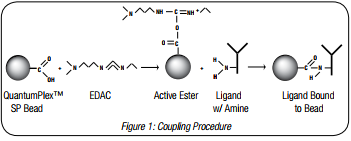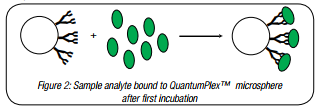磁隔离产品及套件-Magnetic Isolation Products & Kits
Superparamagnetic particles have been utilized extensively in diagnostics and other research applications for the purification of cells and biomolecules, such as antibodies, nucleic acids, and polypeptides. They confer a number of benefits, including ease of separation and suitability for automation. When coated with recognition molecules, magnetic microspheres are ideal for the efficient capture and separation of target. Unwanted sample constituents may be washed away following a simple magnetic separation step.
超顺磁性粒子已广泛用于诊断和其他研究应用,用于纯化细胞和生物分子,例如抗体、核酸和多肽。它们带来了许多好处,包括易于分离和适合自动化。当涂有识别分子时,磁性微球是有效捕获和分离目标的理想选择。不需要的样品成分可以在简单的磁分离步骤后被洗掉。
Description
The QuantumPlex™ kit is designed to be used as a multiplexing platform,
allowing for the efficient, qualitative flow cytometric analysis of a sample for
multiple analytes, or the high throughput screening of multiple samples.
QuantumPlex™ SP is a single population of microspheres sized 4.4µm
(Catalog Code 234) or 5.5µm (Catalog Code 237). The beads are internally
dyed with Starfire Red™ fluorescent dye (fluorescent in FL3). The beads
have a uniform carboxyl (COOH) surface. The COOH surface allows for the
easy conjugation of analytes or analyte-specific antibodies to the surface of
each bead. The beads may then be incubated with a sample and washed
before a fluorescently-tagged reported antibody is added. After a second
wash and resuspension, the beads may be analyzed with a flow cytometer to
determine the presence or absence of the assayed analyte.
Conjugation techniques optimized for the single population of
QuantumPlex™ SP beads may be easily applied to the 5-bead
QuantumPlex™ multiplexing bead array.
QuantumPlex™ 套件旨在用作多路复用平台,允许对样品进行高效、定性的流式细胞仪分析多个分析物,或多个样品的高通量筛选。QuantumPlex™ SP 是一组大小为 4.4µm 的微球(目录代码 234)或 5.5µm(目录代码 237)。珠子在内部用 Starfire Red™ 荧光染料(FL3 荧光)染色。珠子具有均匀的羧基 (COOH) 表面。 COOH 表面允许易于将分析物或分析物特异性抗体结合到样品表面每个珠子。然后可以将珠子与样品一起温育并洗涤在添加荧光标记的报告抗体之前。一秒钟后洗涤和重悬,可以用流式细胞仪分析珠子以确定被分析物的存在或不存在。针对单个群体优化的共轭技术QuantumPlex™ SP 微珠可轻松应用于 5 微珠QuantumPlex™ 多路复用珠阵列。
Characteristics
Mean Diameter: 4.4µm (Catalog Code 234) or 5.5µm (Catalog
Code 237)
Particle Concentration: 1 x 108
microspheres/mL
Material
Material Supplied
• QuantumPlex™ SP microspheres: bottled individually in 1mL or
3mL aliquots
• Storage Buffer: 0.1% BSA, 0.05% Tween® 20, and 10mM EDTA
Material Required
• Analyte or antibody specific to the analyte(s) of interest
• Coupling Buffer: pH 7.2-8.5
• Activation Buffer: pH 4.5-7.5
• Water Soluble Carbodiimide, WSC (EDAC, EDC, CMC, etc.)
• Storage Buffer: 0.01-0.1% (w/v) blocking solution
• Fluorescently-labeled reporter antibody (fluorescent in FL1 or FL2)
Procedure
Researchers are advised to optimize the use of particles in any application.
QuantumPlex™ SP allows for flexibility in designing individual experiments.
The preparation procedure outlines the conjugation of a single antibody to
the QuantumPlex™ bead. In doing so, an assay may be produced which is
capable of testing a single sample for a single analyte. The user may choose
instead to conjugate multiple antibodies of different specificities to the
beads, producing an assay ideal for screening a sample for multiple analytes
in a single test. The user may further choose to conjugate antigen to the
beads, yielding an assay capable of testing for the presence of a specific
antibody. The specific application is to be determined by the user. The
following outline serves as a guide, and may be modified to reflect the user’s
specific application. For a more detailed coupling procedure, see TechNote
205, Covalent Coupling.
建议研究人员在任何应用中优化粒子的使用。QuantumPlex™ SP 允许灵活设计单个实验。制备程序概述了单一抗体与QuantumPlex™ 微珠。 在这样做的过程中,可以产生一种检测方法,该检测方法是能够测试单一样品的单一分析物。 用户可以选择而是将多种不同特异性的抗体与珠子,产生一种理想的检测方法,用于筛选样品中的多种分析物在一次测试中。 用户可以进一步选择将抗原与珠子,产生能够测试特定存在的测定抗体。 具体应用由用户确定。 这以下大纲作为指南,可以修改以反映用户的具体应用。 有关更详细的耦合过程,请参阅技术说明205,共价耦合。
Preparation of Microspheres
1. Vortex the bottle prior to use to ensure uniform suspension of the
beads.
2. Immediately remove 10µL of solution to be labeled with ligand. Note:
The 10µL volume reflects the amount needed to conduct one test using
the given bead population. For ease of use, the entire 1mL or 3mL may
be labeled all at once, and then stored for use with each test.
3. Wash microspheres 2 times with activation buffer, resuspending in
same.
4. While mixing, add WSC.
5. Allow to react at room temperature for 15 minutes with continuous
mixing.
6. Wash 2 times in coupling buffer, resuspending in same.
7. Dissolve ligand to be coupled (1-10X excess of calculated monolayer.
See TechNote 205, Covalent Coupling.) in coupling buffer.
8. Combine microsphere solution and ligand solution, and allow to react at
room temperature for 2-4 hours with constant mixing.
9. Wash and resuspend in quenching solution, and mix gently for 30
minutes.
10. Wash and resuspend in storage buffer at original concentration.
11. Store at 4˚C until used.

Testing Samples
1. Incubate prepared beads with 100µL sample(s) for 30 minutes. (The
volume of sample used may be adapted to the specific application.)
2. Wash beads to remove nonspecifically bound analyte. Repeat the wash
step.

3. Incubate the beads with 20µL of the appropriate fluorescently-labeled
antibody for 30 minutes.
4. Wash beads to remove nonspecifically bound antibody. Repeat the
wash step.

5. Acquire data events using a flow cytometer.
Data Analysis
1. Gate on the single population(s) on a Forward Scatter vs. Side Scatter
plot. (Figure 4)
2. Using the FL1 and/or FL2 channels (depending on the reporter
antibodies used), determine whether or not any bead populations tested
“positive” for the analyte. (Figure 5) Note: A positive bead will produce a
fluorescent peak in the FL1 or FL2 channel. The minimum fluorescence
intensity needed to be considered “positive” is based on the Relative
Channel Value (RCV) of the peak. It is up to the investigator to
determine what threshold RCV value will constitute a “positive” result.
3. The intensity of the Starfire Red dye contained in the bead is used to
differentiate the bead from others in the 5-bead QuantumPlex™ kit.
(Figure 6) When using only the QuantumPlex™ SP beads, the use of
“back-gating” on the red (FL3) signal may be performed to rule out
debris and validate your correct identification of the beads.
1. 前向散射与侧向散射上单个种群的门阴谋。 (图4)
2. 使用 FL1 和/或 FL2 通道(取决于记者使用的抗体),确定是否测试了任何珠群分析物为“阳性”。 (图 5) 注意:一个阳性珠子会产生一个FL1 或 FL2 通道中的荧光峰。 最小荧光需要被视为“积极”的强度是基于相对峰值的通道值 (RCV)。 由调查人员决定确定哪个阈值 RCV 值将构成“阳性”结果。
3. 珠子中所含星火红染料的强度用于在 5 珠 QuantumPlex™ 试剂盒中将珠子与其他珠子区分开来。(图 6)仅使用 QuantumPlex™ SP 微珠时,使用可以对红色 (FL3) 信号执行“反向选通”以排除
碎片并验证您对珠子的正确识别。


Trademarks and Registered Trademarks
1. QuantumPlex™, Starfire Red™, and ProActive® are trademarks or
registered trademarks of Bangs Laboratories, Inc.
2. Tween® is a registered trademark of ICI Americas, Inc.
Storage and Stability
Store at 2-8˚C. Freezing may result in irreversible aggregation and loss
of binding activity. QuantumPlex™ beads are stable for 12 months from
date of purchase, provided the product is handled in accordance with the
manufacturer’s recommendations.
储存于 2-8°C。 冻结可能导致不可逆的聚集和损失的结合活性。 QuantumPlex™ 微珠可稳定保存 12 个月购买日期,提供的产品是按照制造商的建议。
Safety
This particle suspension contains sodium azide. Sodium azide may react with
lead and copper plumbing to form explosive metal azides. Upon disposal of
material, flush with a large volume of water to prevent azide accumulation.
Please consult the Material Safety Data Sheet for more information.
These products are for research use only and are not intended for
use in humans or for in vitro diagnostic use.
这种颗粒悬浮液含有叠氮化钠。 叠氮化钠可能与铅和铜管道形成爆炸性金属叠氮化物。 处置后材料,用大量水冲洗以防止叠氮化物堆积。请查阅材料安全数据表了解更多信息。
这些产品仅供研究使用,不适用于用于人类或体外诊断用途。
Ordering Information
Cat. Code Description Sizes
234 QuantumPlex™ SP Carboxyl 4.4µm 1mL or 3mL
237 QuantumPlex™ SP Carboxyl 5.5µm 1mL or 3mL